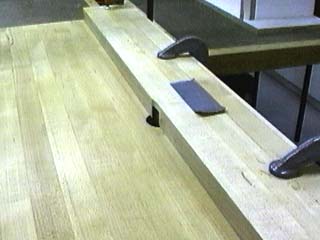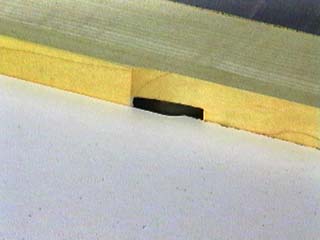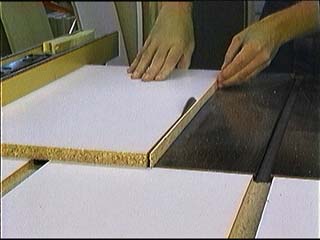

Clean Melamine Edges: By Jim Mattson
Melamine
is a marvelous material. Not only is it inexpensive, but it's
pre-finished, easy to clean, easy to edge-band, and is very stable
as long as you don't soak it in water. It's available in white
at nearly every large home center and most wholesalers stock
black, gray and almond. Custom colors and woodgrained patterns
are available special order in quantity.
I like to use melamine for the interiors of built-ins, behind doors and drawers, and the insides of kitchen cabinets. It's cleanability makes it ideal for kids rooms and a variety of working surfaces. Most of my shop's storage cabinets were quickly made of this plastic-coated particleboard and I always keep some pieces around for jigs and fixtures.
Aside from it's heaviness, melamine's greatest drawback is the difficulty encountered when trying to get a clean cut off the tablesaw. The top side, where the blade enters the panel, is easy to keep smooth while the bottom side, where the blade exits, comes out chipped and ragged. Large manufacturers tackle this problem with a variety of machines like CNC routers and scoring panel saws. Sadly, these are usually beyond the reach of those who operate their trade or hobby from a one-person shop. There are also special sawblades available which advertise clean cutting ability, but my experience leads me to believe the durability of their edges doesn't justify their high price tags.
Luckily, most cuts we'd make building melamine cabinets don't require squeaky clean edges. Backs, some sides, tops and bottoms might be out of sight from the glaring light of scrutiny. Ends which are buried in dados and rabbets, and edges tucked behind a faceframe are also exempt. The problems arise when cutting shelves, dividers and doors. Often these pieces are equally visible from both sides, and the perfectionist in each of us requires a clean cut.
So, what's a cabinetmaker to do???
The following are two techniques I use when working melamine which anyone can employ with only the most rudimentary shop equipment. The first needs a router table (or jointer with carbide knives) and results in the best edges you can get. The second is called half-ripping and uses a tablesaw to produce highly acceptable edges.
The Router Table Method
 |
To get the best edges, relieve the infeed side of your router table fence exactly the amount you need to remove any tearout from normal tablesaw cutting. (I used a jointer to relieve my fence.) In my setup, the maple fence is relieved a hair over 1/8" to get an exact 1/8" stock removal. (Router cuts are a little more fuzzy than tablesaw cuts.) To eliminate snipe or taper cuts, some trial and error is needed on a piece of scrap to properly align the router bit with the outfeed fence. |
 |
This close-up shows the router bit in action. High-quality, large diameter straight bits work best. The linear way material is removed doesn't drag large particleboard chips against the melamine, resulting in a clean cut. Eventually the bit will dull and chipping will slowly crop up. Raising or lowering the bit slightly usually restores the bit's clean-cutting ability. |
This method also works well to straighten any edge irregularities left over from tablesawing. If your melamine crooks slightly after sawing, you can rout the concave edge and re-run the opposite edge through the saw to achieve true parallelness.
If you have problems getting true uniformity of sizes, (some pieces smaller than others), you can use one piece as a template for flush-trimming the rest with a hand-held router and top bearing bit. With large jobs, it might be worthwhile to install a vacuum clamping system on your template, but I like the following technique better for it's speed.
Half-ripping on the Tablesaw
 |
In normal sawing, to get a clean top edge, it's necessary to keep the blade a certain height above the workpiece. Unfortunately, this results in jagged bottom edges because of the steep angle the saw's teeth have when exiting the cut. Large bits of the panels core are dragged against the brittle coating, breaking off little pieces. |
 |
By lowering the sawblade to just over half the panel's thickness, the exit angle is reduced to where chipping is hardly noticeable. |
 |
A comparison of the two cuts reveals a large improvement in quality. Of course, this method doubles the number of cuts performed on each workpiece but in circumstances where you need the accuracy and convenience of using the tablesaw, this additional effort is worth it. |
The best sawblades for half-ripping are fine-toothed, carbide ATBs or triple-chips. ATBs (Alternate Top Bevel) will give a better cut but triple-chip cutting edges are more durable when used against this abrasive material. Naturally, as in all tablesaw cuts, the quality you get is dependent on the trueness of your arbor, the blades alignment with the fence and a steady feed rate. Any weakness with your hardware or tablesaw technique will show up in misaligned or burned half-rips.
I've also found it advantageous to bust out full sheets into smaller parts about half inch oversized before dropping the blade into the half-rip mode. And, best of all, this method works nicely to eliminate any chipouts when cross-cutting plywood.
If you have any questions or comments about what you've just read, feel free to email me direct at The WWA.
Jim Mattson